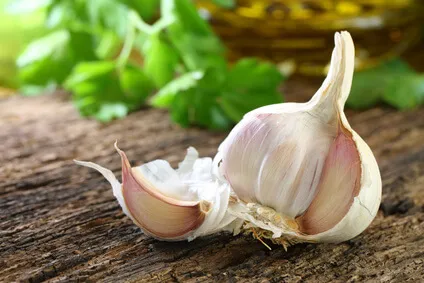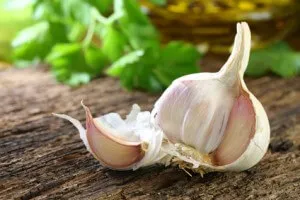
- Share on Facebook154
- Share on Pinterest
- Share on Twitter
Garlic is an herb in the onion family commonly used to add flavor to food. However, it also has potent medicinal qualities that are also used to treat a wide variety of diseases and ailments.
Greek and Roman soldiers even ate garlic before they went to war, and it was also given to slaves who worked on Egyptian pyramids to boost their strength and endurance.
Garlic, which can easily be grown in your backyard, is rich in amino acids, enzymes and vitamins. The sulfur compounds from the amino acid allicin are what produce garlic’s strong odor.
However, don’t let the odor turn you off from this amazingly healthful little herb. Allicin is a powerful antioxidant in garlic responsible for much of its ability to prevent and fight a number of health conditions.
Getting Serious About Garlic
Garlic has antibacterial, anti-fungal and antiviral components. Studies have shown that it is even effective at knocking out antibiotic-resistant bacteria, reducing fungal infections and annihilating viruses and parasites.
The health-promoting qualities of this so called “stinking rose” don’t stop here. Garlic promotes relaxation and enlarges blood vessels, which improves blood flow through the body.
This can prevent high blood pressure and significantly reduces the risk of heart attack and stroke. In addition, garlic keeps plaque from forming on arteries and prevents the oxidation of cholesterol which is known to contribute to heart disease.
Italian and Swiss studies indicate that garlic may even prevent against five known causes of cancer; colon, ovarian, prostate, breast, esophageal
Garlic and Weight Loss
In a highly interesting study published in the American Journal of Hypertension, allicin was found to help keep weight at bay in animals fed a fructose diet. Some animals fed a high fructose diet and garlic together even lost weight.
While, we don’t advocate a high fructose diet, this information helps us better understand the potency of this little herb.
Selecting and Using the Best
Most garlic varieties have similar characteristics and the same strong odor and taste. Garlic with a pink skin is a little sweeter and tends to last longer than white garlic. Elephant garlic has a large clove and is best used as a leek.
Choose loose garlic instead of garlic in a package. This way you can check for freshness easier. When you pick up the garlic, check that the head is firm and has no noticeable brown spots.
Garlic should always be stored in a cool, dark and dry spot. Expect garlic can last anywhere from three weeks to a few months. If a couple of the cloves have gone bad, the rest is still ok, just don’t cut the skin or it will go bad quickly. If garlic starts to sprout, its ok to use, but it may just have a milder flavor.
I f you want strong garlic, squeeze it through a press, for milder garlic, just mince it with a knife. Try to eat garlic raw as much as possible to retain all of its nutrient qualities.
f you want strong garlic, squeeze it through a press, for milder garlic, just mince it with a knife. Try to eat garlic raw as much as possible to retain all of its nutrient qualities.
When garlic is minced, it initiates a reaction that causes the antioxidant to convert into a useful form of the body. This is why it is best to eat it right away after cutting. Add it to salads, soups or even fresh juice.
Garlic Breath?
Many people avoid garlic because they are afraid of having “garlic breath.” After you eat garlic chew on some fresh parsley, mint or citrus peel to neutralize the aroma it leaves on the breath.
Garlic Supplements
Like most other foods, eating garlic is a healthier option than taking a supplement. The same is true for powdered garlic and garlic in a jar. The more processed the garlic, the more nutrients and health promoting components are destroyed.
-The Alternative Daily
- Share on Facebook154
- Share on Pinterest
- Share on Twitter

